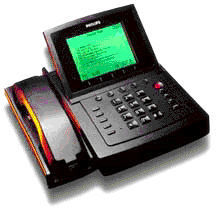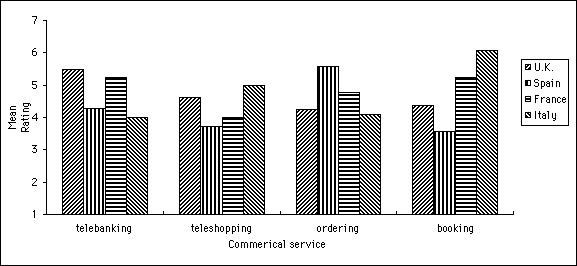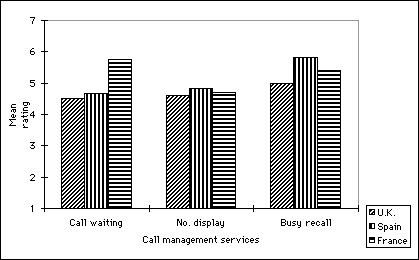An investigation of the user needs for screen-based telephony for people with visual impairments
Valerie Johnson and Helen Petrie
Sensory Disabilities Research Unit
University of Hertfordshire
Hatfield AL10 9AB U.K.
tel: +44 1707 284 629
fax: +44 1707 285 059
email: {v.johnson | h.l.petrie }@herts.ac.uk
Marco Mercinelli
Servizi al Cittadino e Telemedicina
CSELT, via Reiss Romolo 274,
I-10148, Torino, Italy
tel: +39 11 228 6123, fax: +39 11 228 6190
email: marco.mercinelli@cselt.it
1. Summary
The number of facilities provided by the telephone is increasing rapidly. These include call management services (waiting calls, caller identity) and interactive services (banking and shopping services, automatic access to directory enquiries, train and airline timetables and access to the internet and World Wide Web). These services rely on visual interaction with a telephone which incorporates a small screen (a "screenphone") and which uses multi-function "soft keys". It is clear that the use of screenphones could present major problems for visually impaired people. The VISTEL project (Visual Impaired Screen based TELephony ) is investigating the adaptation of screenphones for blind, deaf-blind and elderly users and this paper reports on a series of user requirements studies conducted in four European countries (France, Italy, Spain, and the U.K.) as part of the initial work of the VISTEL project.
| Top |
2. Introduction
The number of facilities provided by the telephone is increasing rapidly. Call management services such as those which inform the user about waiting calls or caller identity are now quite commonplace. Many interactive services are also becoming available via the telephone including banking and shopping services, automatic access to directory enquiries, train and airline timetables and access to the internet and World Wide Web. An indication of how popular these services might becom is given by the enormous success of the range of services has been available in France via the Minitel system for many years.
Access to these services relies increasingly on visual interaction with a telephone which incorporates a small screen (a "screenphone") and which uses multi-function "soft keys" (the five round button immediately under the screen on the telephone illustrated in Figure 1, below). Different labels appear on the screen immediately above these keys to indicate their functions; the functions can change during the course of an interaction, as different options appear on the main area of the screen. It is clear that the use of screenphones could present major problems for visually impaired people. The VISTEL project (Visual Impaired Screen based TELephony ) is investigating the adaptation of screenphones for blind, deaf-blind and elderly users and this paper reports on a series of user requirements studies conducted in four European countries (France, Italy, Spain, and the U.K.) as part of the initial work of the VISTEL project.
 Figure 1: Philips P100 screenphone
Figure 1: Philips P100 screenphone
| Top |
3. Elicitation of user needs
Forty one visually impaired people, some of whom also had a hearing impairment completed a questionnaire specially developed for use within the VISTEL project. Participants were asked about their computer use and their proficiency in reading and or writing Braille. The questionnaire investigated participants' current telephone use and any difficulties encountered. Concerns about the increased use of screenphones were explored and specific requirements for access to this technology were elicited.
3.1. Interest in screenphone services
Participants were asked how interested they would be in the kind of services which may be accessed via screenphon. Participants were asked to rate a number of specific services on a scale of 1 to 7 where 1 means "not at all important" and 7 means "very important". Figures 2 and 3 show the mean ratings given. The level of interest expressed, to some extent, reflected the degree of familiarity the participant had with the service in question. For example, those who already used email and internet services valued these more highly than those who did not. Nearly all the mean ratings are above the mid-point on the scale (a rating of 4) and though it can be seen that standard deviations vary somewhat between countries, a two factor analysis of variance revealed no significant differences, either between ratings given in the various countries, or for the different types of services.

Figure 2: Mean ratings for the importance of telephone access to various commercial services (lines represent one standard deviation)

Figure 3: Mean ratings for the importance of telephone access to various information services (lines represent one standard deviation)
Participants were also asked to rate the importance of various call management services on the scale described above and the mean ratings given for call waiting, calling number display and busy recall services are shown in Figure 4. Again, nearly all mean ratings are above the mid-point on the scale and while standard deviations vary between countries, a two way analysis of variance revealed no significant differences, either between ratings given in each country, or for the different types of services.
Figure 4: Mean ratings and standard deviations for the importance of various call management services (lines represent one standard deviation)
| Top |
4. Recommendations
The questionnaires revealed many useful recommendations and suggestions to be borne in mind when considering screenphone adaptations for visually impaired and deaf-blind people. All participants agreed that adaptations should make screenphones as easy for visually impaired and deaf-blind people to use as for people without these disabilities. Specific recommendations for adapting screenphones for use by visually impaired and deaf-blind people are shown below, categorized as essential, desirable or general recommendations. The essential recommendations are those, which if not adopted, would seriously affect the interest of visually impaired and deaf-blind people in using a screenphone. The desirable features are those which would be good to have. However, provided all the essential recommendations had been met, their absence would not necessarily deter visually impaired people from using a screenphone. The general recommendations are suggestions from participants concerning points which are important to consider when seeking to make screenphone adaptations for visually impaired and deaf-blind people.
4.1 Essential Considerations
- Verbal feedback for actions is crucial
- Option to switch off verbal feedback when/if not required
- Option to switch off non-speech sounds, if used
- Information should be presented in small amounts which can be easily retained
- Use of graphics should be restricted as far as possible (it should be possible to filter graphical or pseudo-graphical information sent by servers)
- Menu systems could be helpful, depressing keys to move on
- General layout of phone, functions and interaction principles should be standardized for all devices on the market
4.2 Desirable Features
- Facilities to stop current information and quickly move about a system
- Choice of languages
- Where possible information should be available in Braille, essential for deaf-blind people
- Phone should be as portable as possible
- Adaptations should be suppressible so phone can be used by others with minimum wear and tear
4.3 General Recommendations
- Cost is a concern and unnecessary time on line should be kept to a minimum. It should be possible to save the info downloaded from a server and to read it afterwards.
- Also to prepare info in local memory before sending it through the network.
- Conduct experiments presenting different kinds and amounts of information
- Test adaptations thoroughly with novice as well as experienced users
| Top |
5. Conclusions
The user needs study produced much useful information about the level of interest in screenphone services amongst visually impaired and deaf-blind people. Many participants expressed real concern that they may suffer serious disadvantage if screenphones became the most common way to access certain services.
In discussing adaptations necessary to make screenphones accessible to them, participants made many useful suggestions concerning interaction methods and functionality. Many participants were concerned about the extra cost of time on line necessitated by their disability and the suggestion was made that the facility to download information from a server to read later would be a great advantage. Similarly the facility to prepare information in local memory before sending it through the network would have the same effect. Many of the suggestions resulting from the user needs studies have already been utilized, both to influence the development of prototypical solutions within the VISTEL Project, and as the basis for further research.
| Top |
6. Acknowledgements
The VISTEL Project (DE 3014) is supported by the Telematics Applications Programme for the Integration of Disabled and Elderly People of the Commission of the European Union (DG XIII). We would like to thank our project partners and all the participants in the user needs study for their assistance.
| Top | | TIDE 98 Papers |
